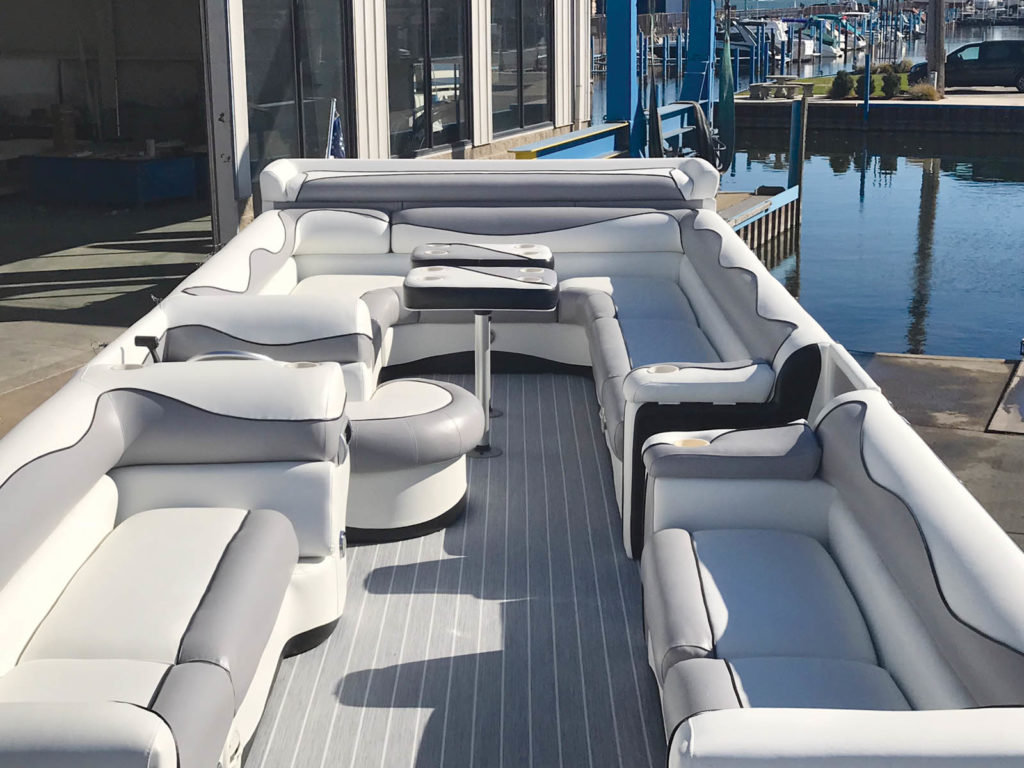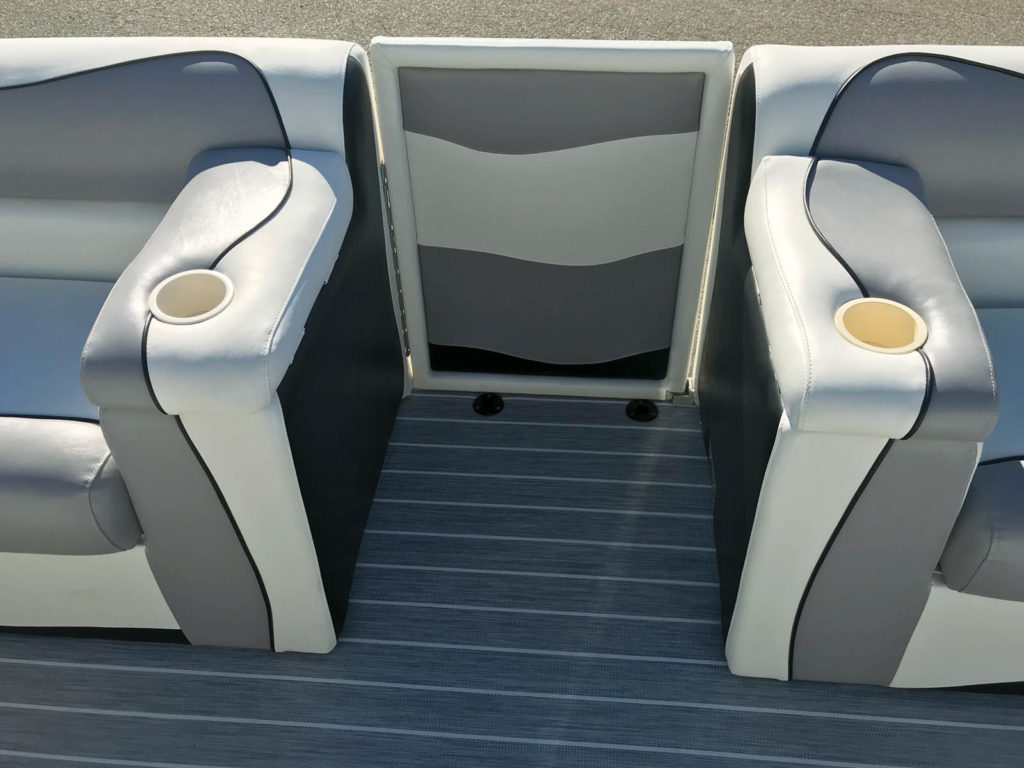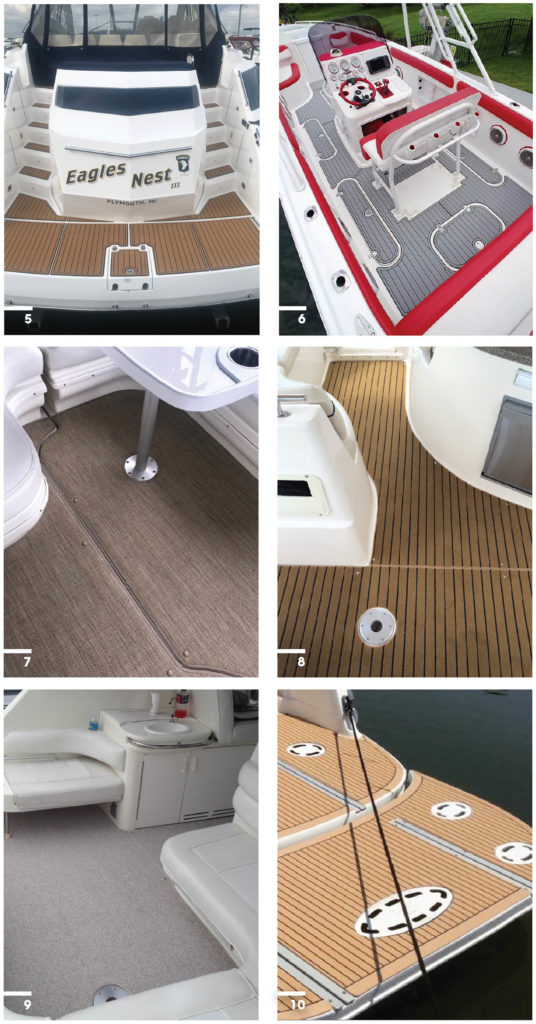Press Releases
Knowledge is power in marine flooring
This article will provide flooring application tips and information about the pros and cons of different types of flooring to help customers make decisions about which products will work best for them.

Narrowing the options
Finding the right flooring for your customers means helping them
choose from among the different options. Here are some critical questions to consider:
- What do your customers want to accomplish?
- What type of flooring do they currently have?
- What suggestions or improvements can you provide to help your customers select a proper floor covering for their boat?
- Will the customers’ choice work well for their application?
- Are your customers educated about the options?
- What can you suggest that will make a lasting impression?

Tips and recommendations
Surface Prep —The most important process of any flooring job is preparing the surface properly. Patterning with craft paper, Canvex® or digital tools can all get you the same results. Just be sure to label and identify the pattern properly. Follow the nonskid or a consistent patterning identifier to give the flooring a streamlined look.
Interior Carpet (Photo 1)—When patterning interior carpet, protect the environment. Apply craft paper or cardboard to cabinets or furniture. Your customer and your team will appreciate this when it comes time to clean up, because removal and installation can be messy jobs. Give yourself adequate lighting and enough space to work in.
Carpet padding is always able to be laid. Just remember that if it gets wet, your customers will have a mess on their hands. Let them know about this before any padding sale or installation. Account for any type of patterns when working with hatches inside the boat.
Keep in mind that some hatches are wrapped and others are cut flush. Glue and staples are your best friend! Some customers like to have custom floor coverings. Provide this as an add-on option to protect the carpets’ texture as well as keeping water off.

Cockpit and Swim Platforms (Photo 2)—When patterning these spaces, you can use craft paper, Canvex (or any clear goods) or digital tools such as Prodim. All are great options. Use Sharpie markers, tape and rulers to give you those straight lines. Remember to have your team identify the top side of the pattern as well as any other helpful instructions. For patterns and teak designs, it is imperative to find the center of the cockpit or platform. With table posts, ensure there is enough clearance while keeping a tight fit, but also leave the ability to get the flooring in the machine for binding, if applicable. Lastly, take photos. This is so important.
Flooring Backings (Photos 3 and 4) —Educate your customers about the type of backings each product has. Many customers have experienced a disintegrating backing and are fearful of a similar product.
EVA Foam (Photos 5 and 6)—This type of flooring comes in different thicknesses, different colors and with unlimited customizations. EVA foam has an adhesive backing, which has a pressure-sensitive application, but now some come with snap-in applications. There are many different brands of products available, so do your homework. This flooring can be a long-term commitment. It can burn due to sun amplification, and it can be very difficult to remove.

Snap-In Carpet (Photo 7)—This is now considered “old-school” flooring; however, many customers still love its soft, plush feel under their feet. It can also act as a sound barrier for engine noise. There still is no way to eliminate the mildew and smell once it gets wet since it is hard to dry and heavy to handle. Need I remind you that this is not kid or red wine friendly?
Snap-In Teak (Photo 8)—This is a more stylish trend than the original snap-in carpet. It is available in 13-foot widths and has a different backing that allows water to run through the carpet. Still, it is at risk for mildew, darker colors may get hot, and just like regular snap-in carpeting, it’s not friendly for spills and stains.
Vinyl Woven Carpet (Photo 9)—One of the newest trends, this type of flooring is mold and mildew resistant, easy to clean and lightweight. Customers trade off a plush feeling for a stylish look. Often, we’re asked about the feel of this underfoot, and we do say this product can get hot. This material could stretch over time, which may result in warranty work.
Synthetic Teak (Photo 10)—This flooring dresses up a boat nicely and is a more affordable alternative to natural teak. It is still a lot of work to maintain and keep clean, very costly and comes with a long-term commitment.
Be a reliable resource
There are many types of flooring options and material suppliers available to fabricators. Educating your customers about their options is critical. Help them understand:
- which products provide specific colors, textures, designs and customization
- which products require a long-term care commitment
- how the flooring will feel underfoot and whether it will get hot
- the cleanability and care options
- the pros and cons for each type of flooring
Being a dependable and well-educated resource for your customers is critical in achieving the right level of customer satisfaction while providing the functionality and look they desire. This will make an impression that will leave your customers bragging about their new flooring and your company!
Rob Kotowski is the second-generation owner of Lake Shore Boat Top Company located in St. Clair Shores, Mich. With a business degree from Walsh College and years of working in the family business as a child, he decided to follow in the footsteps of his father (Bob Kotowski). Rob is currently managing and coaching a staff of 11 and balancing family life with a growing business.
Read the original article at marinefabricatormag.com.


